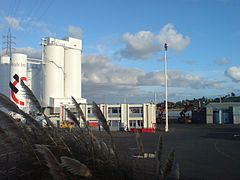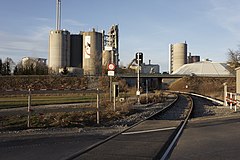Holcim
 | |
| Company type | Division |
|---|---|
| Industry | Building materials |
| Founded | 1912 |
| Headquarters | , Switzerland |
Key people | Miljan Gutovic (CEO) Jan Jenisch (Chairman) |
| Products | Cement, construction aggregate, concrete |
| Revenue | CHF 27.009 billion (2023)[1] |
| CHF 4.577 billion (2023)[1] | |
| CHF 3.176 billion (2023)[1] | |
| Total assets | CHF 52.69 billion (end 2023)[1] |
| Total equity | CHF 26.78 billion (end 2023)[1] |
Number of employees | 63,448 (2023)[1] |
| Parent | Holcim Group |


Holcim is a Swiss-based global building materials and aggregates flagship division of the Holcim Group. The original company was merged on 10 July 2015 with Lafarge to form LafargeHolcim as the new company and renamed to Holcim Group in 2021. The Holcim brand remained active within the group when the merger was completed.
Founded in 1912, the company expanded into France and Europe and the Middle East during the 1920s. They expanded in the Americas during the 1950s and went public in 1958. The company continued to expand in Latin America and added Asian divisions during the 1970s and 1980s. A series of mergers and buyouts made Holcim one of the two largest cement manufacturers worldwide by 2014, roughly tied with rival Lafarge. In April 2014, the two companies agreed to a US$60 billion "merger of equals". The company was the market leader in cement production in Australia, Azerbaijan, India, Slovakia, Switzerland, and Latin America.
Overview
[edit]Holcim is headquartered in Zug, Switzerland, and holds interests in more than 70 countries worldwide. They employ over 63,000 people.[2] Subsidiaries include St. Lawrence Cement (Canada), Aggregate Industries (the UK), and Holcim Apasco (Mexico). The company's products include cement, clinker, concrete, lime, aggregates, and roofing materials.[3] They also offer consulting services, third-party research and development, and land waste management services.[3][4] Their largest business segment is manufacturing and distributing cement and aggregates.[4] As of 2014, Holcim's annual production capacity was 215 million tons.[3] It has a BBB credit rating according to Fitch Ratings, affirmed on March 11 2024.[5]
Holcim is the cement market leader in Australia, Azerbaijan, India, Slovakia, Switzerland, and Latin America. It is among the top few producers throughout Europe, North America, and Asia.[6] Globally, Holcim and Lafarge are the two largest producers in terms of sales as of 2014.[7]
In 2024, Holcim announced its plans to add 1,000 units of the battery-electric truck from Mercedes-Benz Trucks to its European fleet, with both companies signing a joint letter of intent for this purpose. The volume represents the most significant planned single order for the eActros 600, which has contributed to the achievement of the sustainability goals of both companies.[8]
Also, in 2024, Holcim announced plans to spin off its North American business, listing the North American business with a full capital market separation.[9]
History
[edit]Foundation and development
[edit]Holcim was founded by Adolf Gygi in 1912 as "Aargauische Portlandcementfabrik Holderbank-Wildegg".[10][11] The original headquarters were in Holderbank, (Lenzburg district, Canton of Aargau).[10] In 1914, the company merged with "Rheintalischen Cementfabrik Rüthi" owned by Ernst Schmidheiny. Schmidheiny took over leadership duties and began the company on a course of expansion.[11]
In 1922, Holderbank, as the company was then known, expanded beyond the Swiss borders into France. Schmidheiny continued to expand, primarily by buying stakes in existing companies. By the end of the decade Holderbank held stakes in Belgium, Germany, the Netherlands, and Egypt.[11] Positions in Lebanon and South Africa soon followed.[10] Schmidheiny died in the 1930s and his sons, Ernst Jr. and Max, took over the business, splitting it into two divisions. Ernst took over the Holderbank building materials business, while Max oversaw the other lines. This organization scheme remained in place until the 1970s.[11]
After World War II, Hans Gygi, son of Adolf Gygi, took over leadership. He oversaw the company during the Swiss housing boom of the 1950s, and as Holderbank expanded into Canada, then throughout North and South America. The company went public in 1958 in order to raise more capital to fuel further expansion. Hydroelectric projects in Switzerland generated large concrete contracts, offsetting losses in Egypt when the country's government nationalized Holderbank's factories.[11]
During the early 1970s, growth in Brazil and Mexico improved the company's bottom line. The Schmidheiny brothers convinced shareholders that the company should consolidate holdings and merge with Schweizerischen Cement-Industrie-Gesellschaft. The combined company had annual revenue of 800 million Swiss francs and established Holderbank as one of the industry's largest companies worldwide. The oil crisis of 1973 hit the industry hard as construction demand dried up in much of the world. Strong markets in Lebanon and South Africa allowed Holderbank to weather the storm. By 1976, revenue and profits had returned to pre-crisis levels.[11]
In the late 1970s and early 1980s, Holderbank continued its expansion in Latin America and expanded into Asia and Spain for the first time. Thomas Schmidheiny took over leadership, overseeing the company as in expanded into Eastern Europe and experienced a boom in Spanish construction preceding the 1992 Summer Olympics. By 1986, Holderbank was the world's largest cement manufacturer. In the 1990s, the company consolidated its European holdings as the American market drove growth. Expansion into Eastern Europe and Russia continued.[11]
In 2001, the company changed its name from "Holderbank Financière Glaris" to Holcim (short for Holderbank ciment).[10] Asia drove growth in the 2000s, as the company saw more than 50% of its business come from emerging markets.[11] In 2005, Holcim purchased Aggregate Industries for US$4.1 billion, entering the United Kingdom for the first time.[2] That year, the company also expanded into India by acquiring a stakes in The Associated Cement Companies (ACC) and Ambuja Cement Eastern. In 2008, Holcim became the largest shareholder of China's Huaxin Cement with a 40% stake. In 2009, they acquired Cemex Australia.[11]
In February 2012, Bernard Fontana became the first CEO of Holcim that was not part of the founding families.[2]
Merger with Lafarge
[edit]On 7 April 2014, Holcim and Lafarge announced they had agreed to terms on a "merger of equals" valued at nearly $60 billion. The merger entails 10 Lafarge shares being converted into 9 Holcim shares. Holders of 86% of Lafarge shares accepted this offer in June 2015, according to Holcim, meaning that the merger would proceed.[12] The new company would be based in Switzerland and have a manufacturing capacity of 427 million tons a year, which would vastly exceed the 227 million ton capacity of current industry leader Anhui Conch.[7] Lafarge Chief Executive Officer Bruno Lafont will lead the new company, while Holcim's Wolfgang Reitzle will be chairman.[2] Executives from both companies said the deal will save the new company 1.4 billion euros (US$1.9 billion) annually and create "the most advanced group in the building materials industry."[7]
Analysts said the deal could lead to further mergers within the industry and give competitors a chance to pick up assets at a bargain price.[2]
Notes and references
[edit]- ^ a b c d e f https://www.holcim.com/sites/holcim/files/2024-03/28022024-finance-holcim-fy-2023-report-en.pdf.
{{cite web}}: Missing or empty|title=(help) - ^ a b c d e "Holcim Integrated Annual Report 2023 Summary" (PDF). Company. Retrieved 25 August 2024.
{{cite news}}: CS1 maint: url-status (link) - ^ a b c "Holcim Ltd. Company Profile". Yahoo. Retrieved 10 March 2014.
- ^ a b "Holcim Ltd-reg (HOLN:SIX Swiss Ex)". Business Week. Archived from the original on 11 April 2014. Retrieved 10 April 2014.
- ^ Fitch Ratings (24 August 2024). "Holcim LTD Credit Ratings". Fitch Credit Ratings. Retrieved 24 August 2024.
- ^ ICR Research (24 October 2011). "Corporate profile – Holcim". Cemnet. Retrieved 10 April 2014.
- ^ a b c David Jolly (7 April 2014). "Antitrust Hurdles Loom Large for Giant Cement Merger". New York Times. Retrieved 9 April 2014.
- ^ "Holcim Relies on the Mercedes-Benz eActros 600". Bulk & Tipper. 29 January 2024. Retrieved 14 February 2024.
- ^ "Holcim Intends to List North American Business in the US". 28 January 2024. Retrieved 28 January 2024.
- ^ a b c d "About us: History". Holcim. Archived from the original on 18 April 2015. Retrieved 10 April 2014.
- ^ a b c d e f g h i "Holcim history 1912-2012". Holcim. Archived from the original on 13 April 2014. Retrieved 10 April 2014.
- ^ "Lafarge S.A.: Public Exchange Offer Completed Successfully". Bloomberg.
- ^ "Holcim 2023 Integrated Annual Report" (PDF). Holcim Company Website. 28 February 2024. Retrieved 25 August 2024.
